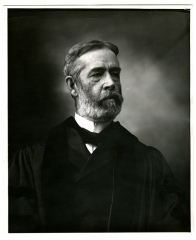the Seminary and Academy from six to seven. Four of the Seminary professors also taught in the College in 1890 but only one nine years later. Of the 1899 faculty, 15 of the 27 had been appointed since 1890-a rather remarkable turnover in less than a decade. These newcomers included: Albert P. Brigham (Geology and Natural History), Ralph W. Thomas (Rhetoric and Public Speaking), Melbourne S. Read (Philosophy), Charles W. ‘Spencer (History), Clement D. Child (Physics), Wayland M. Chester (Biology), George W. Banning (Director of the Gymnasium), George R. Berry (Semitic Languages), Arthur Jones (Homiletics), David F. Estes (New Testament Interpretation), and Frank L. Shepardson (Principal of the Academy).
Faculty appointments represented an attempt to get men of broader educational experience than the old faculty had. Of the new members, in 1899 three had Ph.D.’s, one an M.D. and four had taken advanced work at leading American universities and one at it European university. The first Ph.D., Ferdinand C. French, came in 1892. The Trustees granted leaves of absence to encourage graduate study and travel in Europe and several men took advantage of the opportunities.
Though James C. Colgate and his associates on the Provisional Committee stressed to the Board in 1891 that adequate compensation was necessary to attract and hold men of ability and promise, the Trustees do not appear to have been able to allocate sufficient funds for the purpose. Instructors’ salaries began at a point as low as $800; by 1899 those for senior professors had risen only from $2,200 to approximately $2,500. In resigning to go to the University of Chicago in 1892 Professor Terry frankly admitted to Mr. Colgate that salary was the chief factor in enticing him away.
Unless there were exceptional circumstances, tenure was not granted appointees until the expiration of their first year on the campus. In 1891 the Trustees established the rank of Associate Professor for those whose “experience and attainments”
entitled them to a standing higher than that of instructor but not that of a professor. After 1894 the teachers of both the College and the Seminary organized as the University Faculty to act as single unit on matters of common concern yet each group continued to maintain its separate existence and functions.
During the ’90’s a slight shift in educational philosophy may be observed. Training a Christian ministry and an educated laity re-





